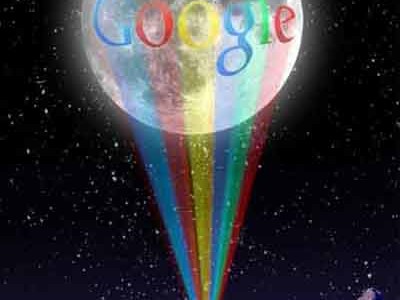Google Moon has Arrived
 To help you prepare, and to wet your appetite for exploration, Google teamed up with scientists at the NASA Ames Research Center to bring you this collection of lunar maps and charts. This tool is an exciting new way to explore the story of the Apollo missions, still the only time mankind has set foot in another world.
To help you prepare, and to wet your appetite for exploration, Google teamed up with scientists at the NASA Ames Research Center to bring you this collection of lunar maps and charts. This tool is an exciting new way to explore the story of the Apollo missions, still the only time mankind has set foot in another world.
1. What am I looking at?
We’ve included four different types of data in Google Moon:
Visible –
A mosaic of images taken by the Clementine mission. This is a black-and-white version of what you would see if you were in orbit around the moon. This composite imagery was prepared by the USGS.
Elevation –
A lunar terrain map generated by the USGS in conjunction with the The Unified Lunar Control Network 2005, and shaded using an airbrushed shaded relief map. This map is color-coded by altitude, so you can use the color key at the lower left to estimate elevations.
Apollo –
A collection of placemarks that tell the story of the Apollo missions that landed on the moon. This includes stories, quotes, images, panoramas, audio clips, and links to videos of the astronauts’ adventures on the lunar surface.
Charts –
A collection of geological and topographic charts of various regions of the moon. Learn more about the charts.
2. How accurate are the maps?
Because the Moon is so far away, it is hard to measure exactly where things on it are. The Visible and Elevation layers were created using images and data that were aligned to the The Unified Lunar Control Network 2005, the most up-to-date understanding of exactly where things are on the Moon, created by the experts at the U.S. Geological Survey. These maps are designed for mission planning, but they will probably still need to be updated once the next generation of lunar mapping satellites arrive at the Moon.
The Charts layer includes maps that were made before these updated coordinate systems existed, and so the positions of features in the charts are only approximate. The high-resolution maps used in the Apollo layer are similarly approximate.
3. Can I see the Moon data using the Google Earth client?
Not yet, but we’re working on it.
4. Where did all this data come from?
The data used to create the Visible and Elevation layers, as well as some of the high-resolution maps used in the Apollo layers, are courtesy of the U.S. Geological Survey.
Much of the rest of the material for the Apollo layer is derived from NASA’s Apollo Lunar Surface Journal.
The USGS Geologic Atlas of the Moon, the Lunar Chart (LAC) Series, and some Apollo imagery are provided by the Lunar and Planetary Institute, managed by USRA.
5. How do I find out more about this data, or the Moon in general?
You can learn more about these images, and find links to many other resources for information about the Moon, from our collaborators at NASA. There’s also a pretty good search engine that could aid you in your quest.
6. I have another question or comment. Where can I send feedback?
If you have comments or questions about Google Moon, we’d love to hear them. Please write to us at [email protected].
-Information courtesy of Google.com, Google Eartha and GoogleMoon

